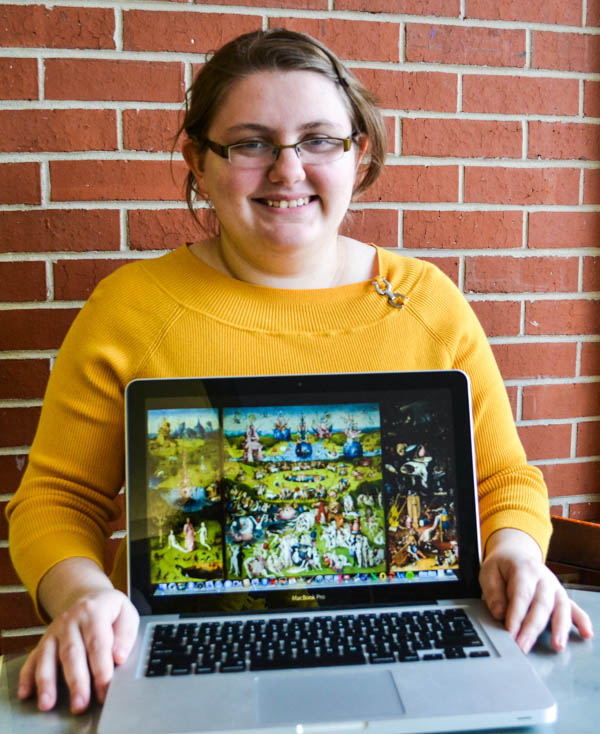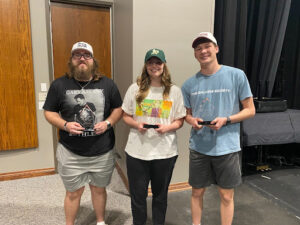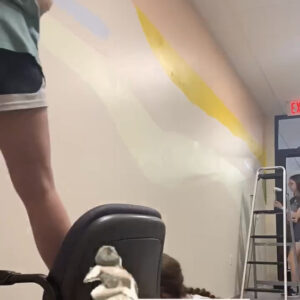Photo by: Abby Bellow
Amelia Hamrick, a junior at Oklahoma Christian University, posted a recording on her blog of a musical piece she found in a painting by Dutch artist Hieronymus Bosch. Little did she know that the discovery would bring her attention from around the world.
“I totally didn’t expect it,” Hamrick said. “I thought a couple of my friends would like or share the post and then … it got really popular on Tumblr, I guess because Tumblr is also full of college-age students who laugh at the combination of butts and music; that was primarily why I posted it in the first place … it’s a song on a dude’s butt.”
Hamrick is double majoring in music and information systems, which is one factor in her desire to make the recording of the painting’s “hidden” music.
Hieronymus Bosch’s “The Garden of Earthly Delights,” where Hamrick found the musical piece on the buttocks of a half-hidden body, portrays the fall of humanity from the Garden of Eden into hell.
“It was all kinds of an accident,” Hamrick said. “Some of the freshmen were talking about Western Thought and Expression, which is one of the honors core classes you’re required to take freshman year. … We had studied the piece called “The Garden of Earthly Delights” by Hieronymus Bosch and it just is a very strange painting.”
The painting captured Hamrick’s attention in the first place since she found it to be such an odd representation of the garden.
“It’s very big with all kinds of strange little details in it,” Hamrick said. “It’s kind of like a ‘Where’s Waldo’ poster, but 500 years old. …We scrolled and found the guy’s butt and found it had music on it. I had taken music history the previous semester and read a little Gregorian notations so I was like, ‘I’m going to transcribe it guys.’ And I did and it didn’t take all that long.”
The attention drawn to Hamrick is largely due to the fact that, supposedly, no one else had found and attempted to play the notes in the painting.
It is possible that others may have discovered the music before Hamrick – but their prior findings were never publicized.
“There’s always a possibility that she’s not [the first one to discover the music],” sophomore Jamie Leake said. “It’s just as possible that no one else said anything.”
Professor of Music John Fletcher agreed with Leake.
“What is surprising to me is that from all indications, nobody else had looked very closely at that particular section of the painting or had attempted to put into modern notation what was shown there,” Fletcher said. “Now having said that … it may be that someone has written a dissertation about that painting and had dealt with that notation. I don’t know, and I don’t think any of us know at this point. But it’s interesting to think that perhaps for 500 years or longer nobody had attempted to do that.”
Once her recording hit mainstream media, Hamrick expressed her distaste for the name she had originally given her recorded piece.
“If I had known that it was historically significant work, I probably would have picked something a little more dignified than ‘The Butt Song From Hell,’ but I mean that’s literally what it is,” Hamrick said.
Hamrick might consider pursuing this particular project.
“Well, there’s no telling,” Fletcher said. “It could very easily spur her onto doing a particular kind of research. She might follow up on this and attempt to do more analysis of music that she finds in this painting or perhaps in other works by Bosch. She might turn this into a project for her honors program, or might turn it into her research paper for a music class, might turn it into a senior project. She might even pursue some sort of publication in an academic journal to deal with it in some way or another. It’s difficult to say what might happen.”
This attention has not come without cost.
“I’ve had a couple interviews over the past few days and it’s been kind of crazy,” Hamrick said. “The whole thing is just kind of overwhelming.”
While Fletcher believed that Hamrick experienced “time crunches” within the past few days, he also saw this as a wonderful thing for her to experience.
“Now in the short term, she may be feeling some time crunch because she’s getting some interview requests from around the world,” Fletcher said. “She did a Skype interview with the Australian Broadcast Cooperation just a couple nights ago, and I just had a request from German National Public Radio to interview about her and to involve her. And she’s had some local media and the Associated Press has contacted her, so its probably taking more of her time right now than she would like it to … but in the big picture, I think it’s a wonderful thing for her.”
As of late, questions have been brought up about Bosch’s intention behind the notes he placed within the painting.
“Nobody has actually tried to make a recording of it,” Hamrick said. “Because everybody assumed, and I’m pretty sure they’re right, that Bosch was just slapping notes on there to make it look like music, not an actual song.”
Fletcher also wanted the answer to this question.
“Well the big question I have about the music and I think Amelia does as well, ‘Is the notation that’s on there, is it intentional that the melody reads as it does?'” Fletcher said. “Could it be that that’s a reference to some existing earlier tune that Bosch was familiar with and wanted to memorialize or incorporate it into the painting for some reason or another, or is it just, ‘These are just a collection of notes that he just wanted some sort of music on there…’”
According to Hamrick, her work with this painting is far from over. She hopes to follow up with more in-depth research of this painting.
“The first thing to do is just go back and clean up the transcription a little bit because I’m pretty sure I made a few mistakes,” Hamrick said. “There’s a couple other places in the piece, the picture, that has music written on it so I think I’d like to transcribe those as well, and of course do research and make sure there’s not any record … of someone transcribing it already, and research more about the painting and the symbolism behind it.”















Be First to Comment